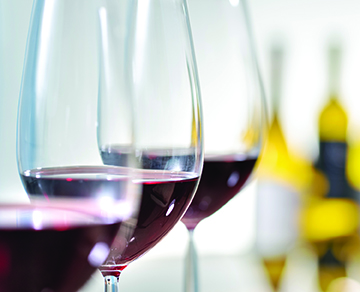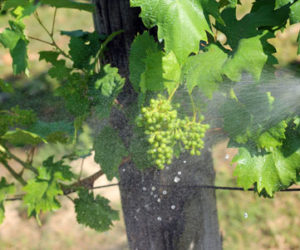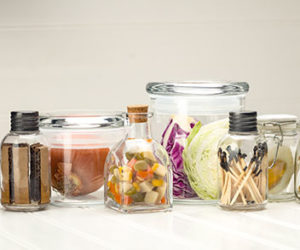
As one progresses in their winemaking hobby, they often learn two things: No two wines are exactly the same and very few wines are perfect from the time the juice is pressed on through post-fermentation. This is where the art, scientific skill, and patience of winemaking really have an opportunity to shine.
After fermentation is complete — both primary alcoholic and secondary malolactic, if desired — the wine is racked a few times off of gross and secondary lees. The bulk maturation process begins in the winemaker’s vessel of choice; either barrel, stainless tank, glass vessel, etc. A few patient months of aging pass and of course curiosity often gets to us: How does it taste? How often have we tasted a wine, and while it is not faulted or flawed, it just isn’t quite right? Either it’s lacking in a desired characteristic such as fruity aroma and flavor, body, color, or it perhaps has too much of a quality such as tannin or astringency. This is an opportunity for the winemaker to really exercise patience, knowledge, and their creative problem solving.
Many issues can either be prevented or amended. There is no better safeguard for your wine in process or aging than high standards of cleanliness and sanitation. Along with sanitizing the wine vessels and processing equipment, ensuring that seals and airlocks are secure and properly filled should be reviewed on a weekly basis.
Proper sanitation practices and SO2 management are the most critical factors in winemaking success and are often covered in any winemaking “basics” articles. Instead, in this article, we will turn our focus to the more detailed techniques used for improving individual characteristics of our wines.
Color
As wine ages, we will often observe fluctuations in its pigmentation. Anthocyanins are the compounds within wine that contribute its color. In red wines, they are responsible for the red to purple pigments that we see making up our wine’s appearance. During fermentation, the anthocyanins polymerize with tannin compounds, helping “lock” each other into the wine; the tannin helps to retain color and the color anthocyanins help to retain tannin content. Adding additional oak tannin at the fermentation step can help lock in many anthocyanins and retain excellent color. If this step is omitted, the winemaker may see a lightening of color as the wine ages, as the anthocyanins will bond with other compounds in the wine and can fall out in some of the precipitate, eventually lost in a racking. I have seen this happen to home winemakers, specifically in the more color-sensitive varieties of Sangiovese, Zinfandel, and even Cabernet Sauvignon, due to the higher levels of the red anthocyanins, such as malvin.
For this loss of pigment, there can be two ways to remediate it post-fermentation. The winemaker can either blend in a darker varietal such as Petite Sirah or Petit Verdot, or they can use a product called Grape Skin Extract (GSE). GSE is made of dehydrated, pulverized, concentrated, and then reconstituted grape skins. Applied in milliliters per liter, this highly concentrated, natural pigment will add color to a wine. A very small amount will contribute deep purple pigments, darkening a wine’s hue and helping to contribute to its opacity.
Clarity
Another issue that is all too common in a young wine is lack of clarity. As the wine ages, lees will flocculate to the bottom of the vessel and form a layer of sediment that the wine will be racked off of. But after about six months of aging, if the wine has not begun to approach any form of clarity (in a white) or has visible suspended solids (in a red), the winemaker may feel at a loss. The winemaker can take one of two major routes to help assist in clarification: Filtering or fining. Both routes are highly efficient ways to clarify a wine and both can have some minor deleterious effects upon the sensory qualities of the wine.
With both red and white wines, before filtering is considered, I often like to try a bench trial of a few products to see if they help with clarification. Sometimes hazes are caused by excess pectin in a wine or higher levels of colloids. Filtering enzymes can help to break down some of these colloidal bonds into smaller structures, either allowing for precipitation to form or will greatly ease filtering later and prevent clogging of the filter media. KS enzyme from Scott Labs has been very successful in my own winemaking as a prefiltration enzyme to help break down colloidal bonds and to help retain color while filtering.
For stubborn haze in white and rosé wines, consider conducting bench trials with bentonite. Bentonite is negatively charged clay derived from montmorillonite. When bentonite is hydrated in water and then mixed into wine it is highly effective at clearing excess proteins from the wine, both clearing up hazy residue and preventing new proteinaceous hazes from forming later in the aging process. Bentonite should not be used on red wines as it can strip out color in its clarification process.
I have occasionally witnessed suspended solids in the wine that look like shining swirls when viewed in clear glass during the red wine maturation process. In my experience, aging alone will not remove these solids and they can easily clog filtration media. They are caused by both positive and negatively charged sediments repelling off of one another and therefore causing each other to stay suspended due to their molecular charge activity. A double fining treatment is necessary to remove both the positive and negatively charged solids and have them flocculate and settle to the bottom of the vessel. Chitosan and kieselsol provide the double fining needed with very gentle results. This treatment can also be used on white and rosé wine with gentle results. If there is concern over potential allergens contributed by the shellfish ingredients often used in chitosan, there are producers who make chitosan products using Aspergillus niger fungal growth in place of shellfish, or gelatin can also be used with kieselsol. Gelatin can bind with excess tannin in the wine, therefore altering its flavor, so bench trials must be conducted to evaluate its overall effects on the wine, not just clarification.
Lack of Aroma
When that critical time comes, when the winemaker’s curiosity gets the best of them and they simply must try the young wine, they will draw out a sample and put it in a glass. A swirl, a sniff, and then sometimes not a whole lot greets their nose when it meets their glass. While I often consider aroma to fall on a wave-like curve as a wine matures; the aroma sometimes fading slightly and then bouncing back with new exciting smells, a wine can easily lack aroma as it matures. If a wine is fermented at very high temperatures some of the esters will volatilize and “burn off” as the wine ferments. Fermentation temperatures can easily skyrocket in a fervent ferment. Without the assistance of cooling jacketed tanks, inserted cooling devices, or moving the warm must to a cooler area to continue its fermentation, wine aromas can suffer greatly from these hot fermentations, and often are lost before the winemaker even realizes.
Luckily, there are a few options that can help to bring back this lost aroma or add to it. Blending is always a good option for adding a desired characteristic to wine. If you have another wine in your cellar that has a much more fruit-forward nose, consider adding a small portion of it to the wine that is lacking. Sometimes a 10–20% addition is enough to revive a dull nose. Bench trials are a simple, fun, and hopefully rewarding way to test out some of these improvement methods. Use small samples of each wine to create different percentage blends in sample sizes and discover if this method helps to improve the aroma of the lacking wine.
There are many products that can help to improve aroma quality if the winemaker doesn’t have an appropriate wine for blending. Winemaking supply and research firms have many different tannin options that boast aroma-enhancing attributes. A simple perusal of their catalogs can give you a bevy of options. I will suggest being cautionary to the technical data sheets of these tannins, and be sure that they are a cellaring and maturation tannin, rather than a fermentation tannin. In this instance of trying to improve aroma quality of the already fermented, young wine, only the former will be of assistance. Some personal favorite products that I have found highly effective and useful for enhancing aromas and flavors of red wine are Enartis’ Unico #2 tannin and BSG’s Liquid Fruit Enhancer Plus tannin. Both may be used in the maturation and aging process. The Unico #2 is tannin derived from the wood of red fruit trees and imparts aromas of cherry, plum, and currants to the red wine. Small doses of even 2–5 grams/hL can freshen up fruit aromas and also provide enhanced fruit flavors to the wine. The tannin is a fine powder that will need to be suspended in a small amount of water or wine before being mixed in thoroughly to the wine. Again, bench trials are imperative to ensure a good result and not to waste excess product. While some immediate effects may be observed, aging of 6–8 weeks will reveal the tannin’s true contribution
and potential.
BSG’s Liquid Fruit Enhancer Plus is liquid tannin that is applied in milliliters per liter and can provide instant results. It contributes big aromas of blackberry, currant, and plum to the red wine upon application. The results are immediate, although better integration will come with time. This product is incredibly handy if you are getting close to bottling time and can’t afford the time to allow powdered tannin to work its magic.
Another, more traditional way to improve aroma is the use of oak. The winemaker can choose from an array of oaks in different species, toasts, and physical forms to enhance their wine. The oak will contribute to the bouquet complexity and can revive an aroma overall with its contribution. Bench trials with numerous different toast levels of different oaks or a medley of different oaks can give the winemaker a lot of great inspiration as to how to improve their wine overall. Neutral oak can also help to improve fresh fruit notes in a dull wine.
Bitterness/Astringency
Now that we have covered ways to improve appearance and aroma of wine, onto discussing improvements on the taste. Sometimes in our early maturation tastings, we will be greeted with some off-putting bitter or astringent flavors. These flavors may coincide with aggressive, grippy tannins that negatively impact mouthfeel. There are quite a few products and fining agents that are easy to use and will successfully diminish bitter off-flavors and coarse tannins in young wine. Noblesse is a non-allergenic, yeast-derived product that can greatly help in reducing bitterness and the “heat” associated with the flavors perceived from high alcohol. It can be used on white, rosé, or red wines. Typical application rate is 0.3 grams per liter. Mix it into a 10% suspended solution before adding to the wine. Mix very well with the entire volume of treated wine. Allow to settle for two weeks and rack or coarse filter off of the remaining sediment. Bitter flavors will be removed and the wine will have less astringency. Fresh fruit flavors are often able to shine through after removing the bitter flavors. I have used this with great success on many wines and have not noticed a significant decrease in perceived color or aroma.
Another way to relieve aggressive, bitter flavors contributed more specifically by tannins is to use a gelatin-based fining agent. Gelatin can be sourced in granule or liquid form. Gelatin works well with a compaction agent such as silica gel. Granular gelatin should be dissolved according to its particular manufacturer’s specifications. There are different Bloom strengths of gelatin and the lowest Bloom strength required to still be effective should be used. I prefer to use 100 Bloom granular gelatins as it is gentler on the wine. Bloom strength will have a great effect on the application rate, so manufacturer’s directions are critical. An added benefit of using gelatin in conjunction with silica gel, aside from the added compaction of the lees, is the reduction in the risk of over fining. This will reduce the risk of loss of color and aroma. Bench trials should always be conducted prior to application to ensure that there is not detrimental color or flavor loss, often by using too much or too strong of a Bloom strength. The liquid preparations of gelatin provide very gentle results on the organoleptic qualities of the wines.
Oxidation
As many home winemakers have discovered, life gets busy and sometimes causes us to not visit and check in on our wines as often as we intend to. Sometimes we can have an accident and seals deflate on tanks, airlocks are knocked over or allowed to dry out, or barrels are not topped off. Each of these will lead to oxidation. While major oxidation cannot really be repaired, very slight oxidation can sometimes be repaired or tastefully covered up. There is not a specific amount of time or circumstance that one can pinpoint as a critical tipping point in oxidation and its potential for recovery. If the wine has only suffered slightly and perhaps lacks bright aroma and flavor, there are quite a few opportunities for rejuvenation. Sulfur dioxide concentration is a critical factor for a wine that has been exposed excessively to oxygen. If testing is available, a free sulfur dioxide concentration should be taken and the wine should be dosed appropriately based upon its pH factor. It will be worthwhile to recheck after two weeks as the free sulfur dioxide will quickly bind to the oxygen and the level will drop. Another dose will likely have to be administered.
Further treatments can be evaluated in bench trials to discover their potential for rejuvenating the wine once the free SO2 level has stabilized. A compound known as polyvinylpolypyrrolidone, or PVPP, has excellent potential ability to remove some negative oxidative effects. There are various formulations of PVPP, so always be sure to follow the manufacturer’s specific instructions for rehydration. PVPP is an incredibly fine powder, giving it a high surface area that allows it to work quickly in the wine. It will precipitate to the bottom over two weeks, but the wine will have to be filtered to 2 microns to properly remove all of the PVPP from its suspension. PVPP can remove some mild brown color tones that are imparted to white wine that has been mildly oxidized. It can really revive aromas and bring back a fresh fruit character to them. While it cannot reverse major damage, it can give a damaged wine its best fighting chance at redemption.
There are other means to refresh a wine that has been damaged due to oxygen contact. Often the aroma compounds volatilize in this process and many are lost. After prolonged oxygen exposure the fragrance of a wine can lack fruit and smell of dried fruit rather than fresh. I would always suggest using PVPP as a first attempt to try and remove the unwanted aromas before administering any other treatments that may cover up smells from oxidation. Using oak to help to regenerate an aroma can be a success. Neutral oak often helps to amplify the perception of fresh fruit with a wine and can contribute mild cedar or floral characters. It can be very helpful in pepping up the aroma and flavors of a white wine. Of course traditional toasted oak can also help to mask some of the oxidized characters of a white or red wine and can help to contribute positive bouquet and flavor elements. Small samples of oak chips can be obtained from barrel and chip manufacturers to help conduct an array of bench trials to evaluate possible remediation.
Fermentation is one of the more exciting and active parts of winemaking; the maturation process is a time of diligence and critical observation. While we always long for each cellaring phase to go smoothly, with the wine consistently improving in quality and complexity, sometimes we are presented with a wine that has some hurdles to overcome on its journey to greatness. With some careful bench trials and the remediation techniques discussed, perhaps some wines will have a better chance at success. Herein lies the relationship of art and science in winemaking: Applied skill marries thoughtful creativity, crafting a delicious glass of wine.







